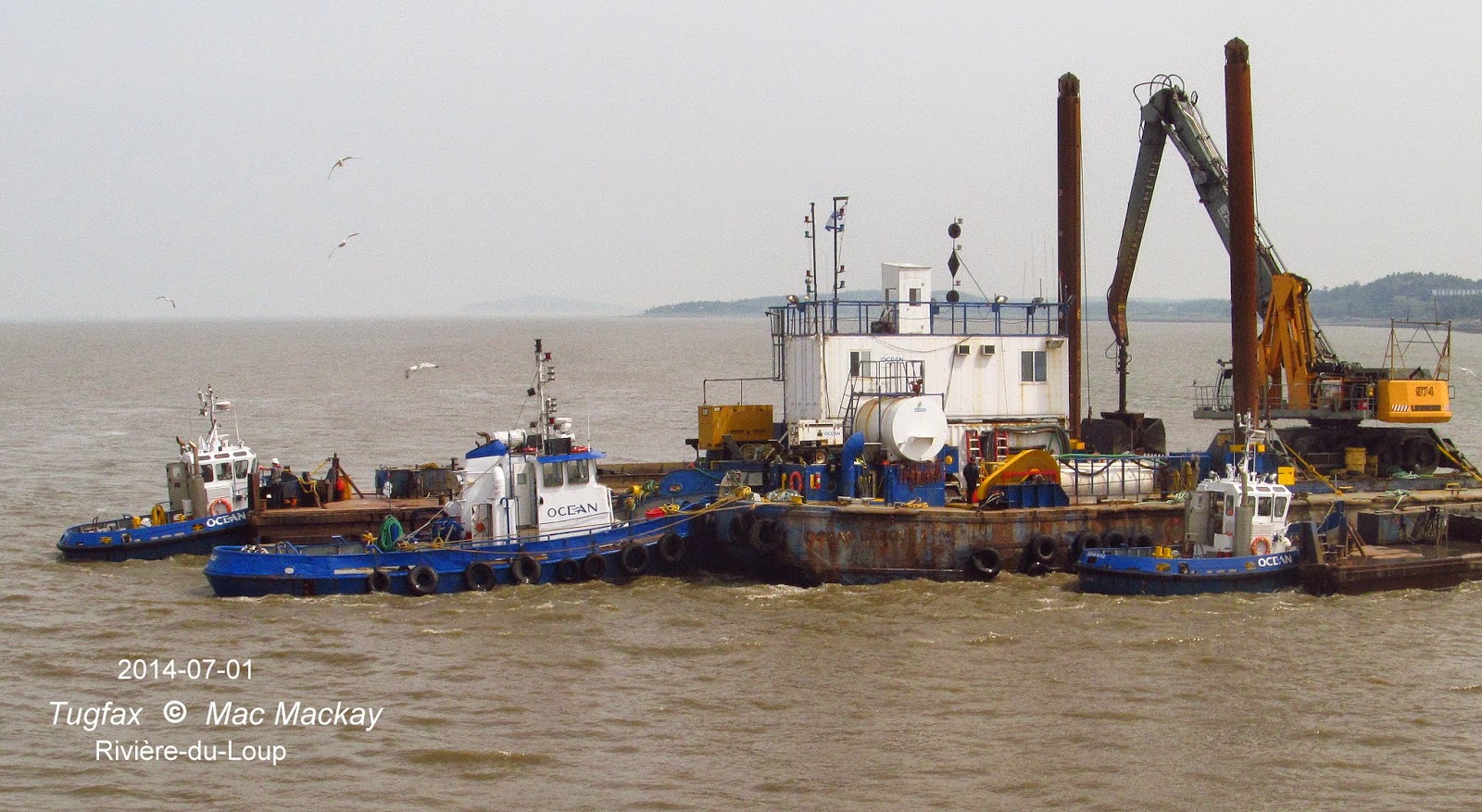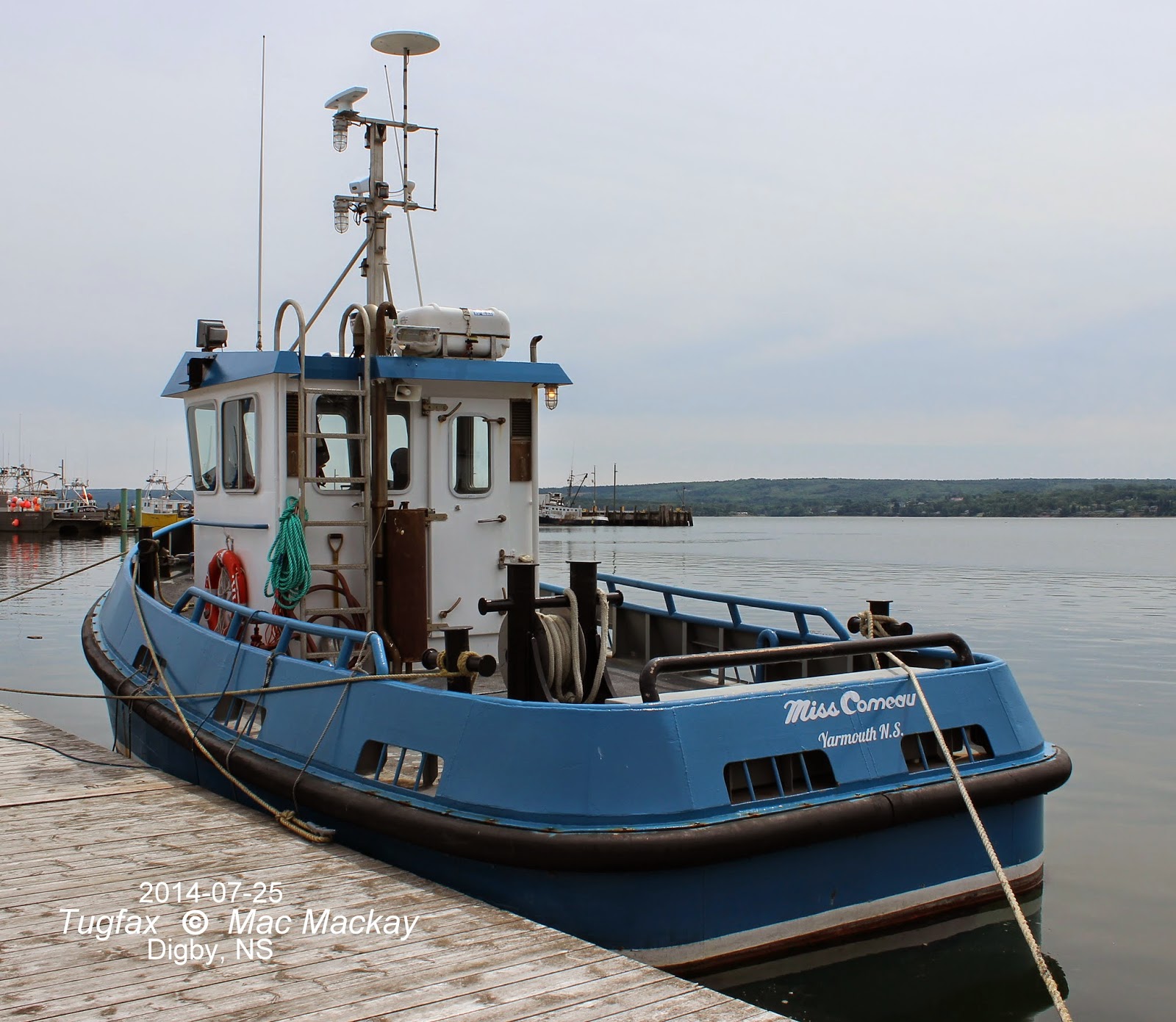A recent posting in
Boatnerd brought back memories of the tug
Tusker that had several far flung careers, one of which had its beginnings in Halifax on this day in 1980.
In July 1954 Rich and Smith of Port Adelaide South Australia commissioned Alexander Hall + Co to build the coastal, harbour and salvage tug at their Footdee shipyard in Aberdeen, Scotland. Hall built the tug with a traditional rivetted steel hull (one of the last ships to be so built in ) However her massive 12 foot diameter bronze prop was housed in a Kort nozzle, which was welded to the hull (a first). Also uniquely, the ship was fitted with two 8 cylinder 850 bhp 2cycle British Polar engines fitted with fluid coupling drives connected to a reverse reduction gearbox. The arrangement allowed the tug to operate economically on one engine, bringing the second engine into operation when full power was needed. Electric bridge controls allowed the engines to be run a 18 rpm up to 128 rpm. At 10 knots she was said to have a range of 1,000 miles. Her top speed was 14 to 15 knots, which was useful for racing to the scene of a casualty.
Of very conventional appearance for the time, she had what looked like a steamship funnel.(In fact numerous steam trawlers built by the yard had almost identical funnels). Her crew of 20 were accommodated below deck aft and forward, also in a very traditional arrangement evolved from steam tugs.
Nevertheless she had an aluminum wheelhouse and aluminum lifeboats.
During construction the Hall yard merged to form Hall Russel, and although the tug was launched in April 1955 strikes and and delays meant that she was not commissioned until January 1958. When it was discovered that her riveted hull was leaking and had hogged after installation of the heavy engines and gearbox, the yard welded in new plates between the ribs from the engines aft. A shallow water bollard pull test came up with a 24.8 ton rating, but it was acknowledged that a higher reading would have been made if the tests had been done in deeper water.
Sailing from Aberdeen February 2, 1958 en route for Gibraltar, the ship ran into bad weather within a week, and was called by the broken down T2 tanker
Stanwell for assistance. Taking the tanker in tow in worsening conditions,
Tusker had the tow line part once but re-connected very close to shore. When the line parted again the German tug
Seefalke was called in. However her line parted and
Tusker reconnected with mooring lines, safely delivering the tanker to La Coruna. No doubt a substantial salvage award was paid.The rest of the trip, through the Suez Canal was uneventful, and the tug arrived in her new home port March 29. She had logged 11,604 miles with 47 steaming days
During the next several years, the tug carried out many long distance tows and salvage jobs, ranging well out into the Pacific and Indian Oceans, including one 4700 mile round trip salvage tow.
By the time she was retired from active service in 1977 she had ranged from Dampier in the northwest to Townsville in the northeast, ranging the west, south and east coasts (including Tasmania) en route.
After some harbour duties the tug was transferred to Abho Pty and towed to Singapore where she was sold.
With Ocean Science and Surveys funnel marking, Tusker was drydocked at the Dartmouth Marine Slips. Although difficult to see in this photo, the tug had a mammoth 12 foot diameter prop in an equally huge Kort Nozzle.
Purchased by Ocean Surveys and Studies of California, she made her way - we believe- from Singapore, then via the Mediterranean to the North American east coast. In 1979 she was seized by US Marshals after being implicated in drug smuggling into Nova Scotia. She was auctioned in South West Harbor, Maine and acquired by McAsphalt Industries and brought to Halifax for reconditioning.
Tusker alongside at the IEL dock where she completed modifications in July 1980.
Modifications for Canadian service included installing new accommodations above the waterline, and other safety features. In appearance however the tug remained largely unchanged.
Fitted for barge service by McAsphalt, the tug spent the next several years working the Lakes, east coast and and as far south as Florida, Alabama and the Bahamas.
July 27, 1980 - Tusker on trials in Halifax.
Capt. Cliff Morrison takes the Tusker out on trials, July 27, 1980.
Tusker's classic funnel, mounted on a riveted deckhouse, featured McAsphalt's striking logo. The capital A represented a paved road with white broken centre line.
McAsphalt sold the
Tusker in early 1985 with a charter back. However the new owners defaulted and McAsphalt were forced to find another buyer. She operated for Sandrin Bros out of Sarnia, ON until major repairs were need in 1989. While those were going on the tug was side swiped by a laker when tied up in Port Colborne and had to be drydocked to reset her Kort nozzle which was jammed against the prop.
After two years in idleness, the tug was sold to Nigerian owners and sailed in May 1992. Renamed
Bode she set out towing the barge
Remi ex
Scurry the rebuilt hulk of the burned out tanker
Hudson Transport. They apparently reached Africa, via Sydney, NS, Bahamas, Canary Islands and Dakar.
In September 1993
Bode was called to assist the ferry
Jumbo in difficulties near San Pedro Ivory Coast, but stranded and was abandoned.
McAsphalt now operates two articulated tug / barge combinations,
Everlast /
Norman McLeod and
Victorious /
John J. Carrick .






















































.jpg)































